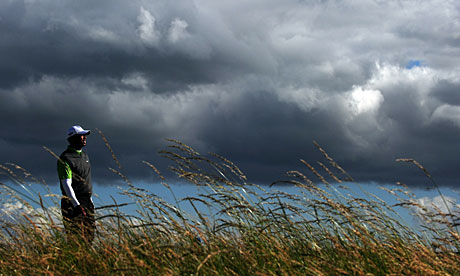After this site revealed a few details about the USGA's golf ball testing (noted by the Wall Street Journal with a USGA/Dick Rugge response), the former USGA Executive Director Frank Hannigan filed this letter in response to the news of rolled back ball testing.
You remember those "short" balls the USGA asked manufacturers to make in limited quantities about 4 years ago? They just re-surfaced at, of all places, the Canadian Tour where players are being paid by the USGA to hit the balls on days following their events. Two tests have now taken place.
The USGA, predictably, will say nothing beyond admitting tests in Canada are happening. The results will never be revealed unless there is a rules change, says USGA technical chief Dick Rugge. He also says they need to protect the "process." A "process" is measuring how far golf balls go? Please.
The USGA, which gets its funds from the public, and shamelessly accepts 501c3 tax status, has one hell of a nerve in trying to shut down a discussion of a distance rollback, the most critical issue in golf for many of its sophisticates.
The issue is what would golf feel like, be like, if the ball went--pick a number--10,15,20 yards shorter for tour players than today's ball. The point of these tests is not where the balls go, it's how the players feel about what they've done.
"Would it make any difference to you if everybody had to play the ball you used today?"
As for the outcome, you can be assured these balls have already been tested to death on the USGA's super-hip indoor driving device which, essentially, can predict the outcome of any hit. The balls were also carefully sprinkled around in exalted golf circles. Peter Dawson gave one to a low handicap friend of mine to play on The Old Course. My friend say he couldn't tell the difference.
So what's going on? Rugge is a very status quo guy, especially when it comes to his salary, which is not short. He doesn't need a fight about distance rollback while he's dealing with the consequences of his dramatic groove change this year. It was billed as a game changer. So far, on the Tour, it has changed nothing. Worse, there will come a time when amateur golfers will be asked to buy new clubs with new grooves that mean absolutely nothing.
Rugge says all players must play with the same grooves lest we have bifurcation. Really? So what about the "one ball" rule, a condition I was involved in with the USGA, which permits committees to limit players to one brand of ball throughout a round. That condition is considered essential on the PGA Tour. It is virtually never used in amateur golf. So is that bifurcation and, if so, what's wrong with it?
My wild guess is that there are members of the USGA Executive Committee who don't want to give up on the issue of distance and have ordered Rugge to do these tests so they can say that with X ball the average driving distance on the Tour would drop by 15 yards--something Rugge already knows.
I would also guess that the PGA Tour knows what's going on. The USGA and R&A can't touch equipment without the consent of the PGA Tour.
This is not a matter of science. BP could surely make a proper shorter golf ball. The matter is political with perhaps some litigation tossed in. All throughout golf, the people who know it best think the ball goes too far. At the British Open annual dinner for former champions at St. Andrews the champions beat up on the R&A about distance. The R&A listens but will do nothing.
What a deal. The people empowered to manage a game can do nothing about the game. It's as if in baseball the major leagues were forced to convert to metal bats.
 I'm sure the R&A's Peter Dawson's fellow powerbrokers at the various tours just loved the International Golf Federation head's answer to the question Tuesday about the tours opening up their books and making public disciplinary actions. Iain Carter reports.
I'm sure the R&A's Peter Dawson's fellow powerbrokers at the various tours just loved the International Golf Federation head's answer to the question Tuesday about the tours opening up their books and making public disciplinary actions. Iain Carter reports.













